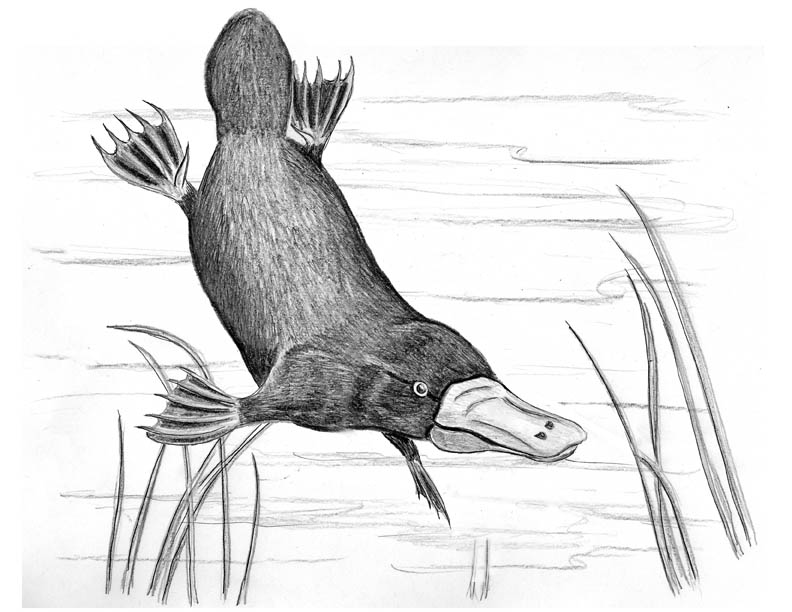
Dear Bird Folks,
I read in one of your recent columns that you have spent time in Australia. I’m planning a trip there myself and one of my goals is to see a Duck-billed Platypus. Any advice where I might find one, or are they too rare to even bother looking?
– Peter, Falmouth, MA
Two things, Peter,
First of all, I only visited Australia briefly and that was twenty-eight years ago. Therefore, I’m not really an expert on the current Aussie wildlife situation. Secondly, and I don’t mean to sound rude, but you know this is a birding column, right? The duck-billed platypus is a duck in name only. It no more belongs in the bird family than one of Boston’s duck boats. To get the best information you really should send this question to the Ask the Platypus Folks guy, but I hear he’s hard to find (mostly because he doesn’t exist). So, in the spirit of the New Year, and because the other questions I’ve received this week are even less relevant, I’ll give it a shot.
To begin with, the creature you are asking about is simply referred to as a “platypus.” The “duck-billed” part was ditched years ago during a downsizing campaign. Platypuses (not platypi, and certainly not platypussies) are only found in Eastern Australia and nowhere else. In addition to their bills, they have beaver-like tails and otter-like webbed feet. And if that isn’t freaky enough for you, they have spurs on their legs that secrete a poison that is strong enough to kill a dog (or a baby-eating dingo). When early British explorers shipped the first platypus specimens back home, the scientists didn’t believe the creatures were real, and I can’t blame them. After all, the Brits have a history of falling for stories about creatures such as dragons, mermaids and Nessie. They didn’t want to get suckered again. But this bizarre animal is very real.
Everything about the platypus is odd, including the name, which is Greek/Latin for “flat-footed.” (Really? It has a duck face and a beaver tail and they named it after its feet? What went on in that meeting?) The platypus belongs to a group of mammals called “monotremes” (which I’m sure you already knew). Monotremes are egg-laying mammals, with platypuses and echidnas (another weird Aussie creature) being the only two members. Ironically, the bill of the platypus isn’t really duck-like; it’s soft and rubbery, and is more like a pair of fat lips (that were injected with way too much collagen). Platypuses live along streams and feed on small aquatic animals hiding in the streambed. However, they don’t use their noses, ears or even their eyes to locate prey. When they dive under water everything closes tight, including their eyes. How can they find food with their eyes closed? Apparently, they can “see” with their bills. Platypus bills have special built-in receptors that can detect the minute electrical impulses given off by their prey. What do they eat? They mostly eat worms, insects and yabbies. I don’t know what yabbies are and I don’t even care. I just like saying it. Go ahead try it, it’s fun!
Platypuses are solitary creatures and only get together briefly to breed, and that’s the extent of their socialization. (Even among friends they don’t like to share their yabbies.) After mating, the female seals herself in an underground chamber and lays two tiny, bean-sized eggs. She then curls her body around the eggs until they hatch, which takes about ten days. During this period she doesn’t eat and survives only on fat stored in her “beaver” tail. Platypus babies are born blind, hairless and hungry, and for the first few months survive on nothing but their mother’s milk. But the nipple-less female even lactates differently than other mammals. When she wants to feed her babies the mother must ooze milk through her skin (now there’s a an attractive sight). The hungry little platypuses then lap the milk off her fur, much in the same way human kids lap the last bit of ice cream off a dish (or maybe that’s just me).
Oddly, there is no official name for baby platypuses. None. They aren’t called puppies, or kittens, or even duckling-bills. This surprised me because Aussies seem to have a special name for just about everything. They even have different names for things that already have perfectly good names. For example: “arvo” means afternoon for some reason; a “click” is a kilometer; and a “tinny” is a can of beer. (That last one must be used a lot because if there is one thing Australians know about, it’s beer.)
Are platypuses rare? No, they aren’t rare, but their numbers are down. Like everything else in Australia, they took a hit when the settlers arrived, because many of their streams were diverted for agriculture. There was even a time when platypuses were hunted for their fur. Fur? Can you imagine having a coat made out of platypus fur? Wearing fur is bad enough, but who needs a coat that oozes milk?
Where to look for them? Since I haven’t been Down Under in forever, Peter, I contacted my friends in Brisbane. They sent me a list of several place to check out, with the best being the Bombala Platypus Reserve in New South Wales. That’s where I would go if I were you. But keep in mind: platypuses are active at sunrise, so get there early. If you don’t see one right away, toss out a handful of fresh yabbies. And if that doesn’t work, you could ooze some milk out of your skin. But I’d try the yabbies first.